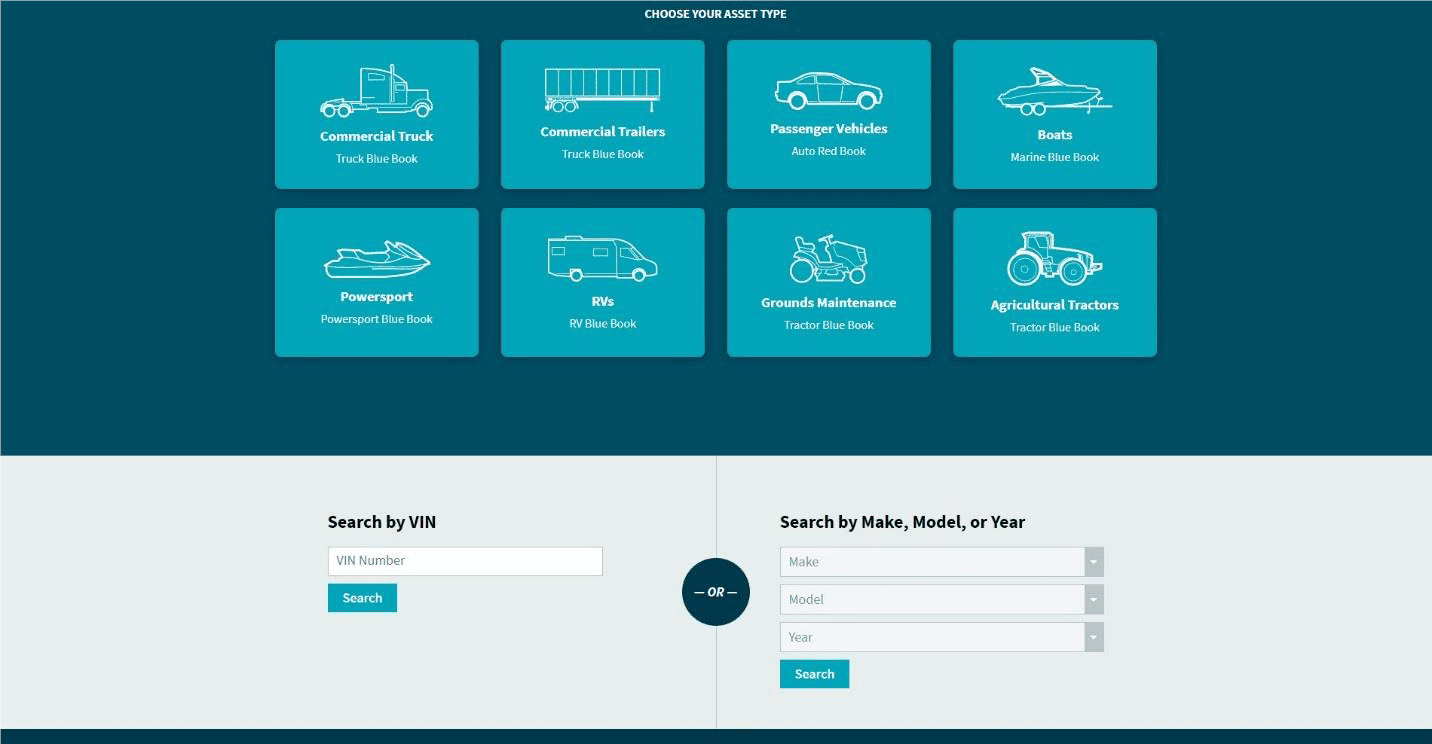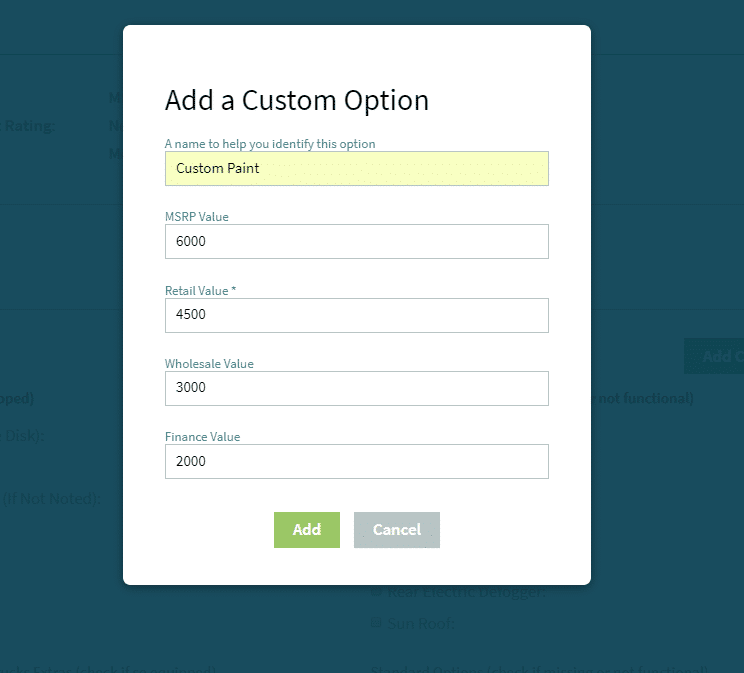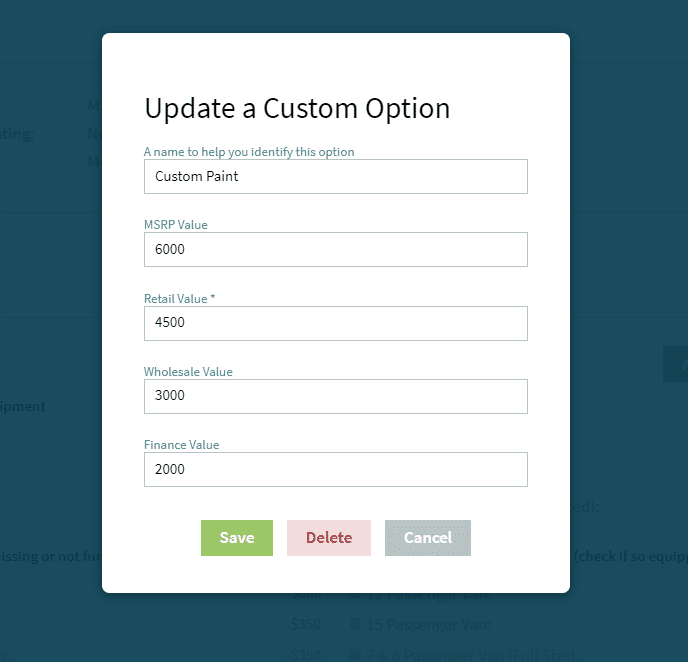Passenger Vehicles
Introduction to Passenger Vehicles (Auto Red Book)
For over 105 years, The Automobile Red Book has served as the trusted source for comprehensive passenger and low speed vehicle VIN-driven identification, specification and market valuations. Find vehicle specs and pricing for nearly every car and light truck manufactured since 1981 including low speed vehicles from 2005 to current. Numerous rich specs including VIN identifiers, weight, MSRP, along with optional equipment, mileage and regional valuation adjustments. Ability to save valuations in inventory for future revisions and valuation, organize in fleets and print or save to .pdf. Updated monthly
Starting a Search
To search for a passenger vehicle from the application home page, first click or tap on the Passenger Vehicles icon. It will turn green when selected.

After the appropriate asset type is chosen, there are two different ways to search for a vehicle.
VIN Verification
Vehicle Identification Numbers (VINs) are important in identifying details specific to a vehicle including the model year, make and model. Accurately decoding a vehicle’s VIN ensures the correct specifications are collected and the proper market values are assessed. Price Digests’ verification tool provides an efficient way to verify a VIN is valid, gather several important details about a vehicle, and value the vehicle with a great deal of precision.

Price Digests decodes VINs of passenger vehicles 1981 to current model year, commercial trucks 1981 to current model year, commercial trailers 2007 to current model year and motorcycles 1981 to current model year, on-road motorcycles only. Coverage is limited to all major manufacturers registered with NHTSA in the U.S. with qualifying production limits beginning in 1981. VINs belonging to vehicles produced prior to 1981 were not required to meet NHTSA standards and thus will not decode within Price Digests data.
To determine if a VIN is valid and review the year, make and model associated with the valid VIN, enter the 17-digit VIN in the box below “Search by VIN” and click “Search”. The VIN will be compared to Price Digests data and results will be shown on the next page.

There are times when you might receive an error code, the codes will tell you the specific reason it could not be searched. Listed below are eight codes you might receive.
- The VIN input has fewer than 17 characters.
- The VIN input contains characters which invalidate the VIN.
- Inputs U, Z, and 0 are not allowed in the 10th position.
- The WMI of the VIN input does not match any known WMIs.
- VIN input does not pass the check digit algorithm.
- VIN entered passes the check digit algorithm but the WMI or model may not be covered within PRD data.
- This model year is outside the scope of this product.
- The WMI of the VIN input does not match any known WMIs.
VINs frequently decode to multiple sub models better known as trims. Though multiple trims may result in the verification process, the VIN used is still unique to the vehicle it belongs. In the event you are unsure which trim to choose, refer to the vehicle’s registration paperwork or the decals at the rear of the vehicle as differences in trim render a difference in values as well as some specifications. To view and select a list of trims that decode to the VIN, click “(1 configurations)” to the right of the screen.

Display specifications will be listed describing key details and differences of each trim. To select the trim that best fits, click on the set of display specifications that best represent the vehicle. For this example we will select the only configuration to populate.

Make/Model/Year Search
The Make/Model/Year search works with at least one of the four fields completed. For example, to find a 2017 Alfa-Romeo Giulia, one could enter any combination of the manufacturer name, the model year, or the model name. Alternatively, if those are unknown, the category search allows for a combination search. It is possible to search for all 2017 Automobiles, or to see results for all Alfa-Romeo Automobiles produced in 2017.

Specifications
Specifications provide a helpful way to compare any asset with the correct configuration in the Price Digests database. Manufacturer publications are the main source of specification data. Though a manufacturer may typically offer many different options on any given model, the standard specifications on the most basic model is shown on each configuration.
Specifications are an easy way to find the configuration that matches an asset. After searching for an asset using the Make, Model, Year search or an appropriate VIN on the home page, the following search screen appears:

In this example, 154 configurations match this Make, Model, Year search. Confirm that the correct asset was returned and select that result. The following page will appear:

The specifications displayed here are called display specs. These are shown to help accurately select the configuration that matches the asset. Once the correct configuration is selected by clicking on the row of display specs, the following page will appear:

This is the configuration page for the specific asset that was searched. At the top of the page you will see the displayed specs that were selected on the previous screen. To see a full list of specifications for this configuration, select the “View full list” button.

The full list of Specifications for a configuration is called the rich specs and is shown when this button is selected. These are intended to give a more precise look at the standard specs applied to the most basic model of an asset. To go back to the display specs, simply select the “Hide full list” button.

For questions on the definition of these specification names, a complete list of specification definitions can be found here: Price Digests Dictionary
Valuations
Price Digests allows users to build vehicle valuations from a base unadjusted car, truck or SUV and add on extra features, options, and adjustments as needed.
Unadjusted values are displayed by default for every base configuration.

Base configuration options are also available. Right below the rich specifications, all available options and extras are listed. Checking any of these options will add them to your vehicle valuation.

If the vehicle has a custom option, it can be added in the Options section.

The custom option feature allows for the addition of options or equipment to be added to the agricultural tractor that may not have come standard. Upon selecting this button, please name the option that is being added along with its MSRP, Retail, High, and Low Values. These values must be determined by the user as each option depreciates in value at its own rate. Once the custom option is filled out, please select the “Add” button.

The custom option will appear as its own line item called “User Defined Optional Equipment”. Values that were determined by the user are added to the overall total value of the asset. Please note, that if a value is omitted in this process, the total value will effectively add zero to that column.

To make any edits or remove the item, hover over the item name in the option section and select “(edit)” when it appears.

The custom option window will come back up which includes the ability to save or delete the custom option.

All changes and updates to the base vehicle configuration are recorded at the bottom of the page. From this area, it’s possible to change the Revision Date of the valuation, as well as Download a copy of the valuation.
Revision Dates are discrete dates on which values were updated. If, for example, a valuation is needed as of January 1st, 2018, click on the drop-down date menu, select a date, and values will update accordingly.

Price Digests also provides a value trend line at the bottom of the screen which displays the last six value revisions of the vehicle. For commercial trucks, this will show the last 6 months of valuations.

For more information on how to download a valuation and/or save a valuation to your inventory, check out our product guide on Saving & Exporting Your Valuation.
After all Options & Extras have been added, Value Adjustments are available to further refine and enhance the valuation.
These adjustments allow for adding premiums or discounts to the value, modifying currency, adding taxes, and making mileage and condition adjustments. All changes will be reflected in the values table in real time.




